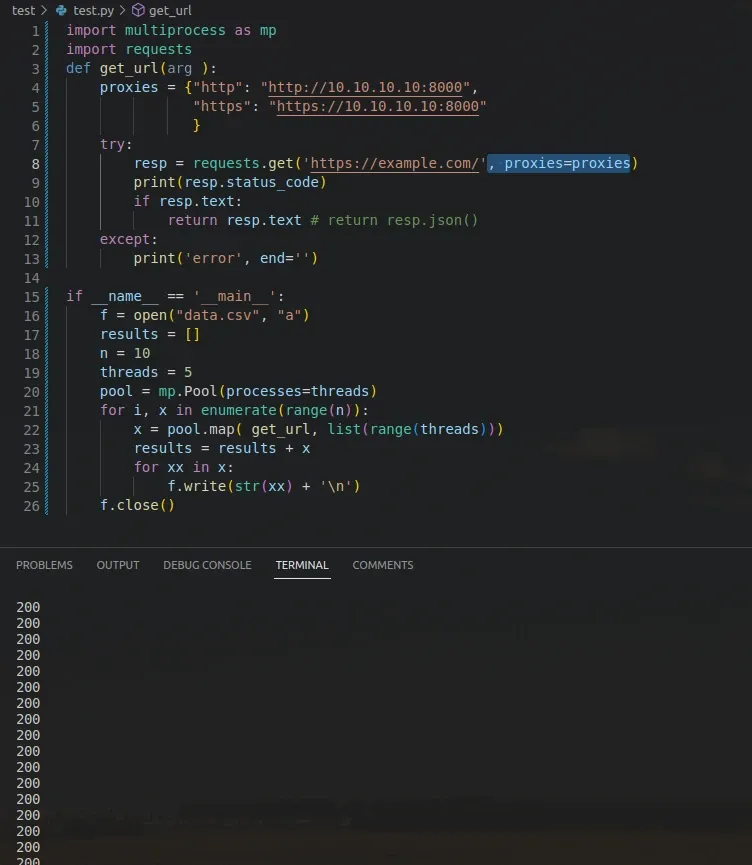To send multiple parallel HTTP requests in Python, we can use the requests library.
send multiple HTTP GET requests
Let's start by example of sending multiple HTTP GET requests in Python:
import requests
urls = ['https://example.com/', 'https://httpbin.org/', 'https://example.com/test_page']
for url in urls:
response = requests.get(url)
print(response.status_code)
We can find the status of each request below:
200
200
404
concurrent - multiple HTTP requests at once
To send multiple HTTP requests in parallel we can use Python libraries like:
- concurrent
- multiprocessing
- multiprocess
- asyncio
The easiest to use is the concurrent library.
Example of sending multiple GET requests with a concurrent library. We create a pool of worker threads or processes. In this example we have 3 concurrent requests - max_workers=3
import requests
from concurrent.futures import ThreadPoolExecutor
urls = ['https://example.com/', 'https://httpbin.org/', 'https://example.com/test_page']
def get_url(url):
return requests.get(url)
with ThreadPoolExecutor(max_workers=3) as pool:
print(list(pool.map(get_url,urls)))
The result of the execution:
[<Response [200]>, <Response [200]>, <Response [404]>]
asyncio & aiohttp - send multiple requests
If we want to send requests concurrently, you can use a library such as:
asyncioin combination withaiohttp
Here's an example of how to use concurrent.futures to send multiple HTTP requests concurrently:
import aiohttp
import asyncio
urls = ['https://httpbin.org/ip', 'https://httpbin.org/get', 'https://httpbin.org/cookies'] * 10
async def get_url_data(url, session):
r = await session.request('GET', url=f'{url}')
data = await r.json()
return data
async def main(urls):
async with aiohttp.ClientSession() as session:
tasks = []
for url in urls:
tasks.append(get_url_data(url=url, session=session))
results = await asyncio.gather(*tasks, return_exceptions=True)
return results
data = asyncio.run(main(urls))
for item in data:
print(item)
Sending the multiple requests will result into simultaneous output:
{'origin': '123.123.123.123'}
{'args': {}, 'headers': {'Accept': '*/*', 'Accept-Encoding': 'gzip, deflate', 'Host': 'httpbin.org', 'User-Agent': 'Python/3.8 aiohttp/3.8.4', 'X-Amzn-Trace-Id': 'Root=1-63g7a39b-1ec5e2ed472cf9bf1874g45f'}, 'origin': '123.123.123.123', 'url': 'https://httpbin.org/get'}
{'cookies': {}}
In the example above, we:
- create a list of URLs that we want to send requests to
- then create a two asynchronous method
- we extract JSON data from the result
- finally we print the results
send multiple requests - proxy + file output
Finally let's see an example of sending multiple requests with:
multiprocesslibrary- using proxy requests
- parsing JSON output
- saving the results into file:
The tests will run 10 times with 5 parallel processes. You need to use valid proxy and URL address in order to get correct results:
import multi process as mp
import requests
def get_url(arg ):
proxies = {"http": "http://10.10.10.10:8000",
"https": "https://10.10.10.10:8000"
}
try:
resp = requests.get('https://example.com/', proxies=proxies)
print(resp.status_code)
if resp.text:
return resp.text # return resp.json()
except:
print('error', end='')
if __name__ == '__main__':
f = open("data.csv", "a")
results = []
n = 10
threads = 5
pool = mp.Pool(processes=threads)
for i, x in enumerate(range(n)):
x = pool.map( get_url, list(range(threads)))
results = results + x
for xx in x:
f.write(str(xx) + '\n')
f.close()
result:
200
200
200
200
200
Don't use these examples in Jupyter Notebook or JupyterLab. Parallel execution may not work as expected!
The result is visible on the image below:

summary
In this article we saw how to send multiple HTTP requests in Python with libraries like:
- concurrent
- multiprocessing
- multiprocess
- asyncio
We saw multiple examples with JSON data, proxy usage and file writing. We covered sending requests with libraries - requests and aiohttp
For more parallel examples in Python you can read:









